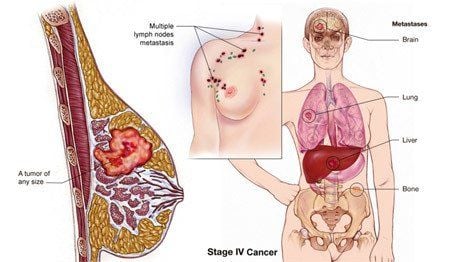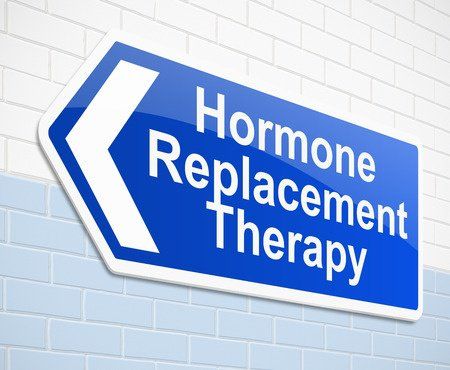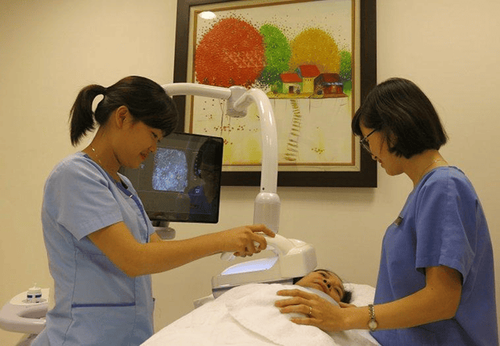This is an automatically translated article.
Stage 4 breast cancer has spread to other parts of the body, such as the bones, brain, lungs, or liver. Therefore, the treatment of late-stage breast cancer needs to combine many methods at the same time to bring high treatment efficiency to the patient.1. Stage 4 breast cancer
Stage 4 breast cancer is also known as terminal breast cancer. At this stage, invasive breast cancer has spread beyond the breast and nearby lymph nodes to other organs of the body such as: distant lymph nodes, skin, lungs, bones, liver, or brain.
Stage 4 breast cancer is often associated with metastases. Patients with stage 4 cancer may be diagnosed at first, or it may be due to a recurrence of previous breast cancer that has spread to other parts of the body.
Metastatic cancer may not be completely curable but it needs to be treated with aggressive systemic therapies. Because cancer has involved different parts of the body, a combination of methods must be used to stop the growth of cancerous tumors and relieve symptoms of the disease.
2. Treatment options for late-stage breast cancer

ung thư vú giai đoạn cuối di căn lên não
Treatment of late stage cancer cannot be completely cured, but it needs to combine many treatments at the same time, including:
Chemotherapy: Chemotherapy is often applied as the main treatment for late stage breast cancer. It has the effect of slowing down the growth of cancer. However, it is often used in combination with hormone therapy.
Patients can access chemotherapy treatment in many different ways, such as taking drugs or liquids containing chemicals to carry out the treatment process. However, usually the specialist will administer the drug intravenously to the patient. Depending on the type of treatment, chemotherapy treatments may be built in cycles and allow the body to rest between treatments.
Hormone therapy: This method can be helpful for women with hormone receptor-positive cancer. That means certain hormones stimulate the growth of breast cancer, and in these women, drugs that stop the tumor from getting the hormone to grow. Commonly used drugs for this treatment include: tamoxifen for all women and aromatase inhibitors such as anastrozole (Arimidex), exemestane (Aromasin) and letrozole (Femara) (used for postmenopausal women) ). Fulvestrant (Faslodex) and toremifene (Fareston) are drugs that block hormone receptors and are sometimes given to women with metastatic breast cancer.
Women who have not yet reached menopause may consider surgical removal of the ovaries to stop them from producing hormones that help cancer grow.

Điều trị ung thư vú giai đoạn cuối bằng liệu pháp hormone
Abemaciclib (Verzenio), palbociclib (Ibrance), ribociclib (Kisqali) are targeted therapies that block certain proteins called CDKs. These drugs are used in some women with hormone receptor-positive and HER2-negative breast cancer.
A new class of drugs called PARP inhibitors have also been found to help treat women with HER2-negative breast cancer who have BRCA-mutant breast cancers. PARP inhibitors include: olaparib (Lynparza) and talazoparib (Talzenna) and target certain proteins that help cancer cells grow. Immunotherapy: Immunotherapy works to stimulate the patient's immune system to find and destroy cancer cells. In women with both hormone receptor-negative and HER2-negative breast cancers, the immunotherapy drug atezolizumab (Tecentriq) is sometimes used in combination with the chemotherapy treatment paclitaxel (Abraxane). Atezolizumab works by blocking a protein called PD-L1.
Clinical Trials: Clinical trials will provide more opportunities for women with late-stage breast cancer. A clinical trial can give patients and doctors access to advanced treatments such as new treatments-new drugs, or new treatments, new drugs combined with new treatments. The treatment is currently in clinical trials.

Hình ảnh siêu âm - tầm soát ung thư vú
Unlike early-stage breast cancer, late-stage breast cancer often has a low prognosis and becomes more difficult to treat. Accordingly, if breast cancer is detected early, the prognosis for treatment is very high, even if it is completely cured and not recurred. Therefore, breast cancer screening is essential, especially for those at high risk of breast cancer.
Currently, Vinmec International General Hospital has been implementing a breast cancer screening package for women of different ages. At Vinmec, there is a full range of necessary medical equipment, a system of modern medical machines to perform methods of examination, diagnosis, testing, imaging, and treatment of breast cancer at many stages. paragraph. Accordingly, the breast cancer examination and treatment process at Vinmec is carried out by a team of highly qualified doctors and nurses who have undergone training and are technically certified, able to handle quickly and effectively. . Therefore, when using Vinmec's breast cancer screening and early detection package, customers can detect cancer even when there are no symptoms, providing a much higher chance of definitive treatment. .
For detailed advice on breast cancer screening packages as well as effective treatment methods at Vinmec, please come directly to Vinmec health system nationwide or register online HERE .













